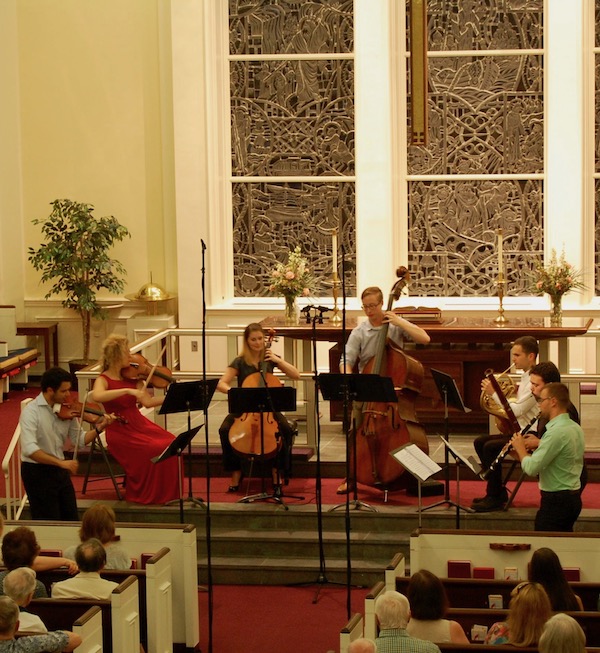Annapolis Chamber Music Festival fills a late-summer void with sea-faring rarities

The Annapolis Chamber Music Festival performed Sunday at St. Martin’s Evangelical Lutheran Church. Photo: Rémy Taghavi
Options are limited for Washington-area classical music fans in late August. Every year around this time the Annapolis Chamber Music Festival comes to the rescue with a week-long series of concerts. The event’s second program, heard Sunday afternoon at St. Martin’s Evangelical Lutheran Church, confirmed expectations for unusual repertoire performed at a high level.
Some of the musicians featured in last year’s festival have returned, along with some new faces. Bassoonist Rémy Taghavi, one of the festival’s co-directors, joined with oboist Tamara Benitez Winston, and pianist Miles Fellenberg for Robert Planel’s Andante et Scherzo, from 1931. Winston’s reedy tone, rounded and buoyant, carried the lovely introduction to the first movement, over undulating chords built on an E pedal in the piano.
While the first movement was redolent of Debussy in a perfumed harmonic style with misty seventh chords, the playful second movement felt closer to Dukas or Poulenc. Taghavi and Winston chattered light-heartedly on their traded, interwoven lines, with Fellenberg’s sensitively rendered piano part in careful support. Winston ascended to some very high notes at climaxes with impressive accuracy.
The heart of the program was Seven Seascapes, written in 2013 by Kevin Puts, a composer who teaches at the Peabody Institute in Baltimore. Composed for the unusual combination of flute, horn, violin, viola, cello, contrabass, and piano, the work was commissioned by the Bridgehampton Chamber Music Festival. The proximity to the shore made it appropriate for Annapolis as well.
Puts created a series of seven bagatelles, each a nugget of unusual sounds and textures inspired by a line or two of poetry from different authors. Taghavi returned to read these words before each movement, without naming the authors, which encouraged the listener to hear how Puts crafted his musical ideas to depict each vignette.
In the first movement, horn player Wilden Dannenberg and flutist Leo Sussman lurched in contrasting rhythm and tonal center against the murmuring piano and strings, an apt evocation of the Emily Dickinson line about an inland soul going to sea. In the second movement, Sussman’s discordant flute cries gave life to the “lone gray bird” against the darkened sea in Carl Sandburg’s words. The third movement, with its Messiaen-like scurrying arpeggio lines, seemed closest in harmonic style to Britten’s famous Sea Interludes.
Pianist Alice Chenyang Xu sparkled in the fast running figures of the fourth movement, corresponding to D. H. Lawrence’s description of “jets of sparks in fountains of blue.” Groaning downward glissandi in the strings were serendipitously answered by a passing siren outside. The fifth movement provided immediate contrast with its sense of stillness, long held notes with occasional oceanic whispers in the flute.
Dannenberg’s sonorous horn was the immutable anchor at the center of the whirling maelstrom of the other instruments, including flutter-tongued flute, in the sixth movement. While the first six movements seemed just long enough to parse their musical ideas completely, the seventh movement was extended through several false endings. Sussman’s silvery low-lying flute solo was followed by an elegiac section for muted strings from violinist Miho Saegusa, of the Aizuri Quartet, violist Hannah Burnett, cellist Madeline Fayette, and bassist Zachary Hobin.
After intermission came a rare performance of the 1895 Serenade for string orchestra by Teresa Carreño. This work by the Venezuelan-American pianist and composer, now found only in a single source at Vassar College, was heard in an arrangement for string quintet. The first movement resonated in a lush romantic style, with a Puccini-like opening section followed by music with a trace of Latin flavor.
Intonation across the five instruments was not always ideal. The Scherzo lost a bit of its Mendelssohnian sizzle with only one player to each complicated part, but the third movement centered on an anguished cello solo from Madeline Fayette, warmly accompanied by her colleagues. The finale, an Elgar-like march that is a bit of a dud, rounded out the concert’s selections.
The Annapolis Chamber Music Festival continues through August 26. chambermusicannapolis.org
